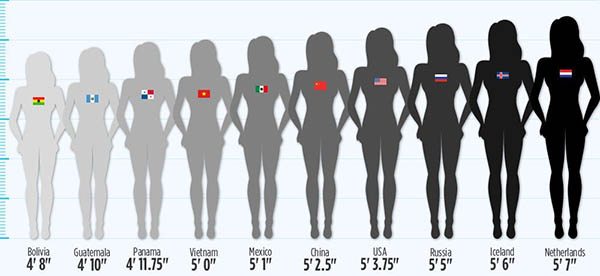You ever look at your kid’s growth chart and wonder, “Wait…is this normal?” Yeah, me too. Whether you’re a parent eyeballing the height percentiles or a teacher noticing how fast (or slow) the girls in your classroom are sprouting up, tracking height isn’t just about curiosity—it’s a marker of development, health, even nutrition. Pediatric growth benchmarks, especially those based on CDC and American Academy of Pediatrics data, help us catch things early—delayed puberty, nutritional gaps, growth disorders.
And here’s the thing: the “normal height for girls” isn’t universal—what’s average in the U.S. might differ wildly from global charts. In the next section, you’ll get a deeper look at those benchmarks, how puberty timing fits in, and what your daughter’s height might really be telling you.
What’s the Average Height for a Girl in the US?
If you’ve ever squinted at a CDC growth chart trying to decode whether your daughter’s height is “normal” or not—welcome to the club. I’ve been there, too, wondering if a quiet growth spurt or a plateau was just part of the ride or something more. The truth is, “normal” is a range, and it shifts with age, genetics, and all those quirky developmental variables (I’m looking at you, puberty timing).
Based on the most recent CDC growth data, here’s a snapshot of median heights for girls across key ages:
| Age (Years) | Median Height (inches) | Median Height (cm) |
|---|---|---|
| 2 | 34.5 | 87.6 |
| 5 | 42.5 | 107.9 |
| 10 | 54.5 | 138.4 |
| 13 | 61.5 | 156.2 |
| 16 | 64.0 | 162.6 |
| 18 | 64.2 | 163.1 |
Now, here’s the part I find most fascinating: Most girls hit 95% of their final height by around age 14, even though the charts go to 18. But if you’re tracking growth percentiles with your pediatrician (which, honestly, you should be), the key is trends, not single numbers.
In my experience, it’s not about where your child is on the chart—it’s about how she’s moving across it over time. More on that in a bit.

How Height Changes as Girls Grow Up
You’ve probably noticed it — one day your daughter’s wearing the same shoes for months, and then suddenly she’s outgrown everything overnight. I’ve seen it countless times (and honestly, it still amazes me). Growth doesn’t happen in a straight line; it moves through distinct phases shaped by hormones, genetics, and timing. Here’s how it typically unfolds:
- Childhood (ages 2–9): Growth is steady here, usually around 2–2.5 inches per year. You might barely notice the changes until you’re comparing last year’s school photo.
- Early puberty (Tanner stage 2–3): This is when estrogen starts to kick in, fueling that famous pubertal growth spurt. For most girls, it happens between 9–12 years old, with peak height velocity—about 3 to 3.5 inches per year.
- Mid-adolescence (Tanner stage 4): Growth slows as skeletal maturity approaches. You’ll often see longer limbs and shifting body proportions—kind of an “in-between” stage that can feel awkward but is totally normal.
- Late adolescence (Tanner stage 5): By 15–16, most girls are within an inch of their adult height.
What I’ve found, working with families over the years, is that early or late puberty timing can shift this entire curve—but it doesn’t necessarily affect final height much. The key is watching velocity, not comparing charts. Every girl’s growth story runs on its own timeline.
Factors That Influence a Girl’s Height
You’re looking at many moving parts when you ask, “what affects a girl’s height?” I’ve tracked growth charts for years and what I’ve found is simple: genetics set the range, environment and habits shape where within that range your daughter lands. Now, here are the key players (with what I tell parents, bluntly):
- Genetics / family health history: Parental height predicts a big chunk of final height (heredity traits), though not perfectly. I’ve seen short parents with tall kids and vice versa.
- Nutrition: Protein intake and micronutrient levels (vitamin D, calcium, iron) directly affect bone growth—so diet matters more than trendy supplements.
- Sleep patterns: Growth hormone pulses during deep sleep; inconsistent sleep blunts pubertal growth velocity. Believe me, bedtime matters.
- Physical activity & lifestyle: Weight-bearing exercise supports skeletal maturity; excessive endurance training (in rare cases) can delay growth.
- Health / endocrinology: Chronic illness or hormonal issues change linear growth; pediatricians watch BMI and percentiles for clues.
What I recommend: focus on steady nutrition, consistent sleep, and tracking trends with your pediatrician—because trends tell the real story.

How US Girls Compare to Global Height Averages
You ever find yourself wondering, “Is my daughter tall… or just tall here?” I’ve had that thought more than once, especially when scrolling through WHO charts and realizing that “average” shifts depending on where you’re standing—literally. The truth is, height norms aren’t global constants, and comparing the U.S. to international benchmarks can be surprisingly eye-opening.
Here’s what I’ve learned digging through WHO and UNICEF data:
- US girls (ages 5–19) rank somewhere around the middle-upper tier globally, with a median height of about 64.2 inches by age 18.
- Dutch girls? Still reigning as the tallest, averaging 66–67 inches by the late teens. (No surprise—they’ve topped height charts for decades.)
- Girls in countries like Guatemala, Indonesia, or India often average several inches shorter—due to a mix of genetic and socioeconomic factors, especially early-life nutrition.
- WHO growth standards are more reflective of global potential, while CDC charts focus specifically on US children’s actual growth patterns, which means they aren’t always interchangeable.
What I’ve found is this: don’t panic over international comparisons. Instead, use them to gain perspective—not pressure. Height’s not a race. It’s a reflection of biology and environment, and those look different everywhere.
When to Be Concerned About Height
Alright, let’s be honest—watching your child grow is mostly amazing… until it’s not. If you’re staring at the growth chart wondering why your daughter hasn’t budged in months (or years), you’re not alone. I’ve sat with plenty of parents in that exact boat, and what I always say is: trust your gut, but also trust the data.
Here are some red flags I personally keep an eye on:
- No visible growth for 6–12 months (especially during puberty years). If her pants still fit from last summer, it’s worth checking.
- Falling off her growth curve (dropping percentiles over time). This one gets missed because kids look healthy—but the chart says otherwise.
- Delayed puberty—no breast development by 13 or no period by 15 could suggest a growth-related issue.
- Extremely short stature (below the 3rd percentile), especially if parents aren’t particularly short themselves.
- Family history of growth disorders, Turner syndrome, or endocrine issues. Genetics sometimes carry surprises.
What I’ve found is that early evaluation—bone age tests, bloodwork, even a visit to a pediatric endocrinologist—can make a huge difference. Don’t wait for a crisis. If something feels off, speak up. You know your kid best.
Can You Predict a Girl’s Final Height?
Ah, the million-dollar question: “How tall will she be?” I’ve been asked this by more parents than I can count—and honestly, I’ve asked it myself. While you’ll never get a crystal-clear number (we’re raising humans, not assembling furniture), there are a few decent tools that can give you a ballpark.
Here’s what you can try:
- Mid-Parental Height Formula: Take Mom’s height + Dad’s height, subtract 5 inches, divide by 2. That gives you a rough target. (I’ve used it dozens of times—it’s simple, but not magic.)
- Bone Age X-ray: A pediatric endocrinologist can order this to assess skeletal maturity, which gives a more precise projection. It’s especially helpful if your daughter is hitting puberty early or late.
- Growth curve analysis: Plotting her height over time using CDC or WHO growth charts can show her trajectory. Look at the pattern, not the dots.
What I’ve found is this: predictions are most useful when they’re paired with context. If your daughter’s growing consistently—even if she’s on the shorter side—she’s probably right on track. Just don’t let an online height calculator stress you out. They’re tools, not verdicts.
Healthy Habits to Support Growth in Girls
I can’t tell you how many times I’ve heard parents say, “What can I do to help her grow taller?” And while you can’t rewrite her genetics, you can set the stage for her body to reach its full height potential—and that starts with habits. I’ve seen it over and over again: small, daily choices stack up.
Here’s what’s actually worth focusing on:
- Calcium + Vitamin D: Think dairy, leafy greens, eggs, salmon. These two are the power couple of bone support. What I’ve found is most kids aren’t getting enough D unless they’re spending real time outside.
- Sleep hygiene: Growth hormone peaks during deep sleep. So yes, those 9–11 hours matter. A consistent wind-down routine (no screens in bed!) really helped in my house.
- Movement routine: Weight-bearing activities like dancing, running, or climbing build strong bones and boost circulation. I always say: if she’s moving and laughing, she’s growing.
- Balanced pediatric diet: Protein, complex carbs, healthy fats—don’t fear the full plate. I’ve made the mistake of focusing too much on “healthy” and not enough on nourishing.
Bottom line? You don’t need fancy supplements or trendy tricks. Just build a routine that supports her from the inside out—and stick with it.
- Related post: Do girls stop growing when they get their period?
